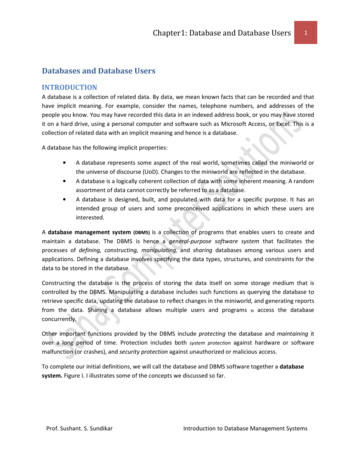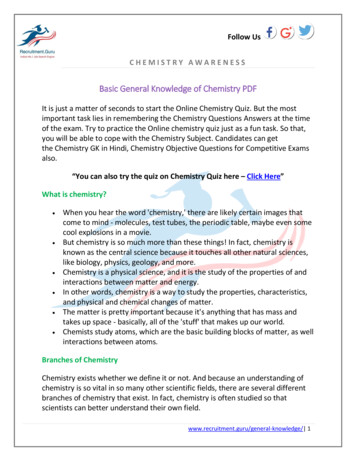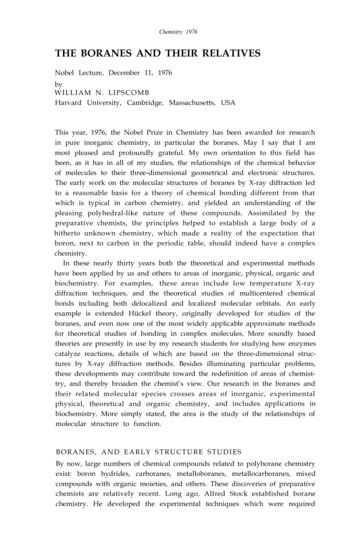
Transcription
Advanced InorganicChemistry (Part 1)Basic Solid StateChemistryWS 05/06(H.J. Deiseroth)
Topics of the complete lecture Introduction – special aspects of the solid state Structure of solids Basic crystallography Characterization of solids: diffraction techniques, electron microscopy,spectroscopy, thermal analysis Bonding in solids Real structure of crystals, defects Electrical, magnetic and optical properties Synthesis of solids Structure-property relations
Resources
ResourcesTextbooks:Shriver, Atkins, Inorganic Chemistry (3rd ed, 1999)W.H. Freeman and Company (Chapter 2, 18 .)recommendationgermanvery good, but not basic levelInternet resources http://ruby.chemie.uni-freiburg.de/Vorlesung/ (german) http://www.chemistry.ohio-state.edu/ woodward/ch754. (pdf-downloads) IUCR-teaching resources (International Union for Crystallography,advanced level)
ResourcesJournals
Outline – 15.10.041. Introduction2. Structure of solids2.1 Basics of structures2.2 Simple close packed structures: metals2.3 Basic structure types (structure of simple salts)2.4 More complex structures2.5 Complex structures2.6 Structure of nanomaterialsOxides.
1.Introduction
1.IntroductionWhy is the solid state interesting?Most elements are solid at room temperature
1. IntroductionSpecial aspects of solid state chemistry Close relationship to solid state physics Importance of structural chemistry knowledge of several structure types understanding of structures Physical methods for the characterization of solids X-ray structure analysis, electron microscopy thermal analysis, spectroscopy, conductivity measurements . Investigation and tuning of physical properties magnetism, conductivity, sorption, luminescence defects in solids: point defects, dislocations, grain boundaries Synthesis HT-synthesis, hydrothermal synthesis, soft chemistry strategies for crystal growth (physics)
1. IntroductionClassifications for solids (examples) Degree of order long range order: crystals (3D periodicity) long range order with extended defects (dislocations ) crystals with disorder of a partial structure (ionic conductors) amorphous solids, glasses (short range order) Chemical bonding – typical properties covalent solids (e.g. diamond, boron nitride): extreme hardness . ionic solids (e.g. NaCl): ionic conductivity . metals (e.g. Cu): high conductivity at low temperatures conductivity: metals, semiconductors, insulators, superconductors magnetism: ferromagnetism, paramagnetism Structure and Symmetry packing of atoms: close packed structure (high space filling) characteristic symmetry elements: cubic, hexagonal
2.Basic Structures
2.1 Basics of StructuresVisualization of structuresExample: Cristobalite (SiO2)Description of packingDescription of environmentDescription of topologyBragg jun. (1920)Sphere packingPauling (1928)PolyhedraWells (1954)3D nets
2.1 Basics of StructuresApproximation: atoms can be treated like spheresConcepts for the radius of the sphereselement orcompoundscompoundsonly d/2 of single bondin molecule d – r(F, O )problem: reference!elements orcompounds(„alloys“) d/2 in metal
2.1 Basics of StructuresTrends of the atomic radius atomic radii increase on goingdown a group. atomic radii decrease across a period particularities: Ga Al (d-block)(atomic number)
2.1 Basics of StructuresTrends of the ionic radii ionic radii increase on going down a group radii of equal charge ions decreaseacross a period ionic radii increase with increasingcoordination number (the higher its CN thebigger the ions seems to be !!) the ionic radius of a given atom decreaseswith increasing charge (r(Fe2 ) r(Fe3 )) cations are usually the smaller ions in acation/anion combination(exception: r(Cs ) r(F-))cf. atomic radii
2.1 Basics of StructuresDetermination of the ionic radiusIonic radius d – r(F, O )Structure analyses,most important method:X-ray diffractionL. Pauling: Radius of one ion is fixed to a reasonable value (r(O2-) 140 pm) That value is used to compile a set of self consistent values for other ions.
2.1 Basics of StructuresStructure and lattice – what is the difference?Example:structure and latticein 2D Lattice pattern of points no chemical information, mathematical description no atoms, but points and lattice vectors (a, b, c, , , ), unit cell Motif (characteristic structural feature, atom, group of atoms ) Structure Lattice Motif contains chemical information (e. g. environment, bond length ) describes the arrangement of atoms
2.1 Basics of StructuresUnit cellUnit Cell (interconnection of lattice and structure) an parallel sided region of the lattice from which the entirecrystal can be constructed by purely translational displacements contents of unit cell represents chemical composition(multiples of chemical formula) primitive cell: simplest cell, contain one lattice point
2.1 Basics of StructuresUnit cell – which one is correct?Conventions:1. Cell edges should,whenever possible,coincide withsymmetry axes orreflection planes2. The smallestpossible cell (thereduced cell) whichfulfills 1 should bechosen
2.1 Basics of StructuresUnit cells and crystal system millions of structures but 7 crystal systems crystal system particular restriction concerning the unit cell crystal system unit cell with characteristic symmetry elements (later)Crystal systemRestrictions axesRestrictions anglesTriclinic--Monoclinic- Orthorhombic- Tetragonala b Trigonala b Hexagonala b a b c Cubic
2.1 Basics of StructuresIndices of directions in space“[110]”, square brackets for directionsProcedure in three stepscba1. Select 0002. Mark position of second point3. Draw vectorConvention: right-handed coordinate system middle finger: a forefinger: b thumb: c
2.1 Basics of StructuresIndices of directions in space – examplesc[111]bac[110]ba
2.1 Basics of StructuresIndices of planes in space“(110)” round brackets for planesProcedure in three stepscba1. Select 0002. Mark intercept (1/h 1/k 1/l)of the axes (if possible)3. Draw planeConvention: right-handed coordinate system
2.1 Basics of StructuresIndices of planes in space – examplesc(112)bac(110)ba
2.1 Basics of StructuresFractional coordinates Rules for marking the position of an atom in a unit cell: fractional coordinates are related to directions possible values for x, y, z: [0; 1] atoms are generated by symmetry elements negative values: add 1.0, values 1.0: substract 1.0 (or multiples) Example: Sphalerite (Zincblende)factionalcoordinates Equivalent points are represented by one triplet only equivalent by translation equivalent by other symmetry elements, later
2.1 Basics of StructuresNumber of atoms per unit cell (Z) Rectangular cells: atom completely inside unit cell: count 1.0 atom on a face of the unit cell: count 0.5 atom on an edge of the unit cell: count 0.25 atom on a corner of the unit cell: count 0.125Example 1: SphaleriteExample 2: Wurzitenumber of atoms 2number of atoms 1 Wyckoff-notation: number of particular atom per unit cell
2.1 Basics of StructuresWyckoff-notation - exampleCrystal dataFormula sumCrystal systemSpace groupUnit cell dimensionsZMg2SiO4 (Olivine)orthorhombicP b n m (no. 62)a 4.75(2) Å, b 10.25(4) Å, c 6.00(2) Å4Atomic coordinatesAtomMg1Mg2Si1O1O2O3Ox. 2 2 289(1000)
2.1 Basics of StructuresWyckoff-notation and occupancy-factorsCrystal dataFormula sumCrystal systemSpace groupUnit cell dimensionsZCu0.8 In2.4 Se4tetragonalI -4 2 m (no. 121)a 5.7539(3) Å c 11.519(1) Å2Atomic coordinatesAtomCu1In1In2Se1Ox. 1 3 1/41/21/8 Occ. factor 1.0: mixing of atoms and vacancies on the same position Calculation of the composition: Cu: 2 0.8; In: 4 1 2 0.4; Se: 8 1
Summary to 2.1 Atoms can be treated (and visualized) like spheres Different types of radii Structure and lattice Unit Cell 7 crystal sytems Indexation of directions and planes Fractional coordinates Z: number of atoms per unit cell Wyckoff-notation and occupancy factors
2.2 Simple close packed structures (metals)Close packing in 2Dprimitive packing(low space filling)close packing(high space filling)
2.2 Simple close packed structures (metals)Close packing in 3DExample 1: HCPclose packed layer1Example 2: CCPclose packed layer2
2.2 Simple close packed structures (metals)Unit cells of HCP and CCPHCP(Be, Mg, Zn, Cd, Ti, Zr, Ru .)close packed layer: (001)anticuboctahedronspace filling 74%CN 12CCPcuboctahedron(Cu, Ag, Au, Al, Ni, Pd, Pt .)close packed layer: (111)
2.2 Simple close packed structures (metals)Calculation of space filling – example CCPSpace filling Volume occupied by atoms (spheres)Volume of the unit cell4r 2a3 4r 3V ( cell ) a 2 4ZV ( sphere) 4 r 33 4 4 r 3 2 spacef . 3 3 0.744r 6 2
2.2 Simple close packed structures (metals)Other types of metal structuresExample 1: BCC(Fe, Cr, Mo, W, Ta, Ba .)space filling 68%CN 8Example 2: primitive packing( -Po)space filling 52%CN 6Example 3: structures of manganesealpha Mnbeta Mngamma Mn
2.2 Basics of StructuresVisualization of structures - polyhedraExample: Cristobalite (SiO2)Bragg jun. (1920)Sphere packingPauling (1928)PolyhedraWells (1954)3D nets
2.2 Simple close packed structures (metals)Holes in close packed structuresTetrahedral holeTHTetrahedronOctahedral holeOHOctahedron
2.2 Simple close packed structures (metals)Properties of OH and TH in HCP and CCPHCPNumberOH/THLocationDistancesOH/THOH, TH in HCPCCPOH, TH in CCPn/2nn/2nOH: 4 corners, all edgesTH: inside unit cellOH: center, all edgesTH: center of each octant!very short!Connection oftetrahedra, HCPConnection ofoctahedra, HCPno short distances
Summary to 2.2 Concept of close packing (layer sequences, unit cell, space filling) Structure of metals Holes in close packed structures
2.3 Basic structure typesOverview„Basic“: anions form CCP or HCP, cations in OH and/or THStructure typeExamplesPackingHoles filledOH and THNaClAgCl, BaS, CaO, CeSe,GdN, NaF, Na3 BiO4 , V7 C8CCPn and 0nNiAsTiS, CoS, CoSb, AuSnHCPn and 0nCaF2CdF2, CeO 2, Li2O, Rb2O,SrCl 2, ThO2 , ZrO2 , AuIn2CCP0 and 2nCdCl2MgCl2 , MnCl2 , FeCl2, Cs 2O,CoCl2CCP0.5n and 0CdI2MgBr 2, PbI2 , SnS2 ,Mg(OH) 2, Cd(OH)2 , Ag2 FHCP0.5n and 0Sphalerite (ZnS)AgI, BeTe, CdS, CuI, GaAs,GaP, HgS, InAs, ZnTeCCP0 and 0.5nWurzite (ZnS)AlN, BeO, ZnO, CdS (HT)HCP0 and 0.5nLi3BiLi 3AuCCPn and 2nReB2!wrong! (LATER)HCP0 and 2n
2.3 Basic structure typesPauling rules: understanding polyhedral structures(1) A polyhedron of anions is formed about each cation,cation,the cationcation-anion distance is determined by the sum of ionic radiiand the coordination number by the radius ratio: r(cation)/r(anion)r(cation)/r(anion)Scenario for radius ratios:worst caseoptimumlow space filling
2.3 Basic structure typesPauling rules: understanding polyhedral structures coordinationanion polyhedronradius 41Si, Al6octahedron0.41-0.73Al, Fe, Mg, Ca8cube0.73-1.00K, Na12close packing(anti)cuboctahedron1.002r(anion)Example: OctahedronRadius ratiooctahedral coordination2 2 r ( anion) 2r ( cation) 12r ( anion)r (cation)2 1 0.414r ( anion)2r(anion) 2r(cation)
2.3 Basic structure typesPauling rules: understanding polyhedral structures(2) Negative and positive local charges should be balanced.The sum of bond valences sij should be equal to theoxidation state Vi of ion i: Vi sijExample 1-TiO2 (Rutile)CN(Ti4 ) 6, CN(O2-) 3:sij(Ti-O) 2/3 sij(Ti) 4, sij(O) 2Example 2 - GaAs (Sphalerite)Example 3 - SrTiO3 (Perovskite)CN(Ga3 ) 4, CN(As3-) 4: sij 3/4CN(Sr2 ) 12, CN(Ti4 ) 6, sij(Ga) 3, sij(As) 3CN(O2-) 4(Sr) and 2(Ti)sij (Sr-O) 1/6 , sij (Ti-O) 2/3
2.3 Basic structure typesPauling rules: understanding polyhedral structures(3) The presence of shared edges, and particularly shared facesdecreases the stability of a structure. This is particularly truetruefor cations with large valences and small CN.(4) In a crystal containing different cations those with largevalence and small CN do not tend to share polyhedronelements with each other.(5) The number of chemically different coordination environmentsfor a given ion in a crystal tends to be small.
2.3 Basic structure typesNaCl-typeCrystal dataFormula sumCrystal systemSpace groupUnit cell dimensionsZNaClcubicF m -3 m (no. 225)a 5.6250(5) Å4Atomic coordinatesAtomNaClOx. 1-1Wyck.4a4bNaClx01/2y01/2z01/2Structural features: all octahedral holes of CCP filled, type antitype Na is coordinated by 6 Cl, Cl is coordinated by 6 Na One NaCl6-octaherdon is coordinated by 12 NaCl6-octahedra Connection of octahedra by common edges
2.3 Basic structure typesBonding in ionic structures – Coulomb interactionClassic picture of ionic bonding: cations donate electrons to anions thuseach species fullfills the octet rule.i.e. Na F Na FInteraction between anions and cations: Coulomb interactions.z z e AN4 0 rAB2V ABCoulomb potentialof an ion pairVAB: Coulomb potential (electrostatic potential)A: Madelung constant (depends on structure type)z: charge number, e: elementary charge 1.602 10-19C 10-12C2/(Nm2)o: dielectric constant (vacuum permittivity) 8.85 rAB: shortest distance between cation and anionN: Avogadro constant 6.023 1023 mol -1
2.3 Basic structure typesBonding in ionic structures – Coulomb interactionCalculating the Madelung constant (for NaCl)1286A 6 .234First term: attraction from the 6 nearestneighborsSecond term: repulsion (opposite sign)from 12 next nearest neighbors First coordinationsphereSecondcoordination sphereThird coordinationsphereA converges to a value of 1.748.ACNRock Salt1.7486CsCl1.7638Sphalerite1.6384Fluorite5.0398
2.3 Basic structure typesBonding in ionic structures - repulsionRepulsion arising from overlap of electron cloudsBecause the electron density of atomsdecreases exponentially towards zero atlarge distances from the nucleus theBorn repulsion shows the samebehaviourr0rapproximation:BV Born nrB and n are constants for a given atomtype; n can be derived fromcompressibility measurements ( 8)
2.3 Basic structure typesLattice energy of a ionic structure1) Set the first derivative of the sum to zero2) Substitute B-parameter of repulsive part0 L Min.(V AB V Born)2zze10 AN (1 )L4 0 r0n typical values, measured (calculated) [kJ mol-1]: NaCl: –772 (-757); CsCl: -652 (-623) measured means by Born Haber cycle (later) fraction of Coulomb interaction at r0: 90% missing in our lattice energy calculations: zero point energy dipole-dipole interaction covalent contributions, example: AgCl: -912 (-704)
2.3 Basic structure typesSphalerite-typeCrystal dataFormula sumCrystal systemSpace groupUnit cell dimensionsZZnScubicF -4 3 m (no. 216)a 5.3450 Å4Layer in sphaleriteStacking sequenceAtomic coordinatesAtomZn1S2Ox. 2-2Wyck.4a4cx01/4y01/4z01/4Structural and other features: diamond-type structure 50% of tetrahedral holes in CCP filled connected layers, sequence (S-layers): ABC, polytypes Zn, S is coordinated by 4 S, (tetrahedra, common corners) applications of sphalerite-type structures very important(semiconductors: solar cells, transistors, LED, laser )
2.3 Basic structure typesWurzite-typeCrystal dataFormula sumCrystal systemSpace groupUnit cell dimensionsZZnShexagonalP 63 m c (no. 186)a 3.8360 Å, c 6.2770 Å2Atomic coordinatesAtomZn1S1Ox. 2-2Wyck.2b2bx1/31/3y2/32/3z03/8Structural features: connected layers, sequence (S-layers): AB Zn is coordinated by 4 S (tetrahedra, common corners) polytypesStacking sequence
2.3 Basic structure typesCaF2-typeCrystal dataFormula sumCrystal systemSpace groupUnit cell dimensionsZCaF2cubicF m -3 m (no. 225)a 5.4375(1) Å4Atomic coordinatesAtomCa1F1Ox. 2-1Wyck.4a8cCoordination Cax01/4y01/4Structural features: all TH of CCP filled F is coordinated by 4 Ca (tetrahedron) Ca is coordinated by 8 F (cube)z01/4
2.3 Basic structure typesCdCl2-typeCrystal dataFormula sumCdCl2Crystal system trigonalSpace groupR -3 m (no. 166)Unit cell dimensionsa 6.2300 Å, 36 Z1Atomic coordinatesAtomCd1Cl1Ox. 2-1Wyck.3a36iStacking sequencexyz0000.25(1) 0.25(1) 0.25(1)Structural features: layered structure, sequence (Cl-layers): ABC Cd is coordinated octahedrally by 6 Cl (via six common edges) polytypesOne layer
2.3 Basic structure typesCdI2-typeCrystal dataFormula sumCrystal systemSpace groupUnit cell dimensionsZCdI2trigonalP -3 m 1 (no. 164)a 4.2500 Å, c 6.8500 Å1Atomic coordinatesAtomCd1I1Ox. 2-1Wyck.1a2dx01/3y02/3z01/4Stacking sequenceStructural features: layered structure, sequence (I-layers): AB Cd is coordinated octahedrally by 6 I (via six common edges) polytypes
2.3 Basic structure typesIntercalation of layered compounds Reversible intercalation of atoms between the layers of a layered compound Host-guest interactions, structure-property relationsExample 1: Graphite Electron donors (alkali metals, e. g. KC8) Electron acceptors (NO3-, Br2, AsF5.) Properties: Increase of interlayer spacing, color change,increase of conductivity, change of electronic structurexLi (metal) xLi (solv) xexLi (solv) TiS2 xe- LixTiS2(s)Li metal Electron donors(alkali metals, copper, organic amines) Application: Li-TiS2-batteryTiS2Example 2: TiS2 (CdI2-type)Li salt in DME/THF
2.3 Basic structure typesLi3Bi-typeCrystal dataFormula sumCrystal systemSpace groupUnit cell dimensionsZLi3BicubicF m -3 m (no. 225)a 6.7080 Å4Atomic coordinatesAtomBi1Li1Li2Ox. 0 0 0Wyck.4a4b8cUnit cellx01/21/4y01/21/4Structural features: all holes of CCP filled by Li not many examples of this structure typez01/21/4
2.3 Basic structure typesNiAs-typeCrystal dataFormula sumCrystal systemSpace groupUnit cell dimensionsZNiAshexagonalP 63/m m c (no. 194)a 3.619(1) Å, c 5.025(1) Å2OctahedraAtomic coordinatesAtomNi1As1Ox. 3-3Wyck.2a2cx01/3y02/3z01/4Structural features: all OH of HCP filled Ni is coordinated by 6 As (octahedron) metal-metal-bonding (common faces of the octahedra) As is coordinated by 6 Ni (trigonal prism) type antitypeTrigonal prismsOctahedron andtrig. prism
Summary to 2.3 Pauling rules Lattice energy calculations of ionic structures Structures of basis structure types:NaCl, ZnS, CaF2, CdCl2, CdI2 , Li3 Bi, NiAs
2.4 More complex structuresIntroduction“More complex”: deviations from close packing of anions no close packing of anions cations in simple (highly symmetrical) polyhedra other species besides tetrahedra and octahedra complex interconnection of the polyhedra
2.4 More complex structuresOxides: Rutile (TiO2)Crystal dataFormula sumCrystal systemSpace groupUnit cell dimensionsZTiO2tetragonalP 42/m n m (no. 136)a 4.5937 Å, c 2.9587 Å2Octahedra in RutileAtomic coordinatesAtomTi1O1Ox. 4-2Wyck.2a4fxy000.30469(9)z00.30469(9)0Structural features: no HCP arrangement of O (CN(O,O) 11) mixed corner and edge sharing of TiO6-octahedra columns of trans edge sharing TiO6-octahedra,connected by common corners many structural variants application: pigment
2.4 More complex structuresOxides: ReO3Crystal dataFormula sumCrystal systemSpace groupUnit cell dimensionsZ1ReO3cubicP m -3 m (no. 221)a 3.7504(1) ÅAtomic coordinatesAtomRe1O1Ox. 6-2Wyck.1a3dx01/2y00z00Unit cellStructural features: no close packing (CN (O,O) 8) ReO6 octahedra connected by six common corners large cavity in the center of the unit cell filled phase (AxWO3 tungsten bronze)
2.4 More complex structuresOxides: undistorted perovskite (SrTiO3)Crystal dataFormula sumCrystal systemSpace groupUnit cell dimensionsZSrTiO3cubicP m -3 m (no. 221)a 3.9034(5) Å1Unit cellCuboctahedronAtomic coordinatesAtomSr1Ti1O1Ox. 2 4-2Wyck.1a1b3cx01/20y01/21/2z01/21/2Structural features: filled ReO3 phase, CN (Ca) 12 (cuboctaehdron), CN (Ti) 6 (octahedron) many distorted variants (even the mineral CaTiO3!) many defect variants (HT-superconductors, YBa2Cu3O7-x) hexagonal variants and polytyps
2.4 More complex structuresOxides: Spinel (MgAl2O4)Crystal dataFormula sumCrystal systemSpace groupUnit cell dimensionsZMgAl2O4cubicF d -3 m (no. 227)a 8.0625(7) Å8Atomic coordinatesAtomMg1Al1O1Ox. 2 72Diamond DocumentDiamond DocumentStructural features: distorted CCP of O Mg in tetrahedral holes (25%), no connection of tetrahedra Al in octahedral holes (50%), common edges Inverse spinel structures MgTHAl2OHO4 InTH(Mg, In)OHO4 Application: ferrites (magnetic materials)
2.4 More complex structuresOxides: Spinel (Fe3O4)500 nmMagnetospirillumOcher
Summary to 2.4 More complex structures Rutile ReO3 Perovskite and structural variations Spinel and structural variations
2.5 Complex structuresOxides: Silicates- overview 1From simple building units to complex structuresStructural features: fundamental building unit: SiO4 tetrahedron isolated tetrahedra or connection via common corners MO6 octahedra , MO4 tetrahedra (M Fe, Al, Co, Ni )NesosilicatesSiO44Olivine: (Mg,Fe)2SiO4SorosilicatesSi2O76Thortveitite: (Sc,Y)2Si2O7CyclosilicatesSiO 32Beryl: Be3Si6O18
2.5 Complex structuresOxides: Silicates- overview 2Inosilicatessingle chain: SiO32Pyroxene: (Mg,Fe)SiO3double chain: atesSi2O52Biotite: K(Mg,Fe)3AlSi3O10 (OH)2
2.5 Complex structuresOxides: Silicates- overview 3TectosilicatesSiO2Faujasite: Ca28 Al57 Si135O384 -cageT-Atom- representation
2.5 Complex structuresConcept for visualization of topologyT-Atom representation3D-Nets:Knotenedge vertex
2.5 Complex structuresIntermetallics- overviewSolid solutions: Example: RbxCs1-x BCC-structure, disordered chemically related small difference of electronegativity similar number of valence electrons similar atomic radius (high temperature)Ordered structures: from complex building units to complex structuresRule: complex structuresException:simple structuresCuZn
2.5 Complex structuresIntermetallics- Hume-Rothery-phasesTrend 1:Intermetallics with a defined relation between structure and VEC(Valence Electron Concentration)Number (N) of valence electrons (empirical rules):0: Fe, Co, Ni, Pt, Pd; 1: Cu, Ag, Au2: Be, Mg, Zn, Cd; 3: Al; 4: Si, Ge, Sn; 5: SbVEC N(val. electr) / N(atoms) (both per formula unit)VEC3/23/23/221/137/4StructureCuZn -MnHCP g3InAu5SnCu5Zn8Cu9Al4Cu31 Si8CuZn3Cu3SnAg3Sn
2.5 Complex structuresIntermetallics- Laves-phasesTrend 2:Intermetallics with a high space filling (71%)Typical radius ratio: Al2BaMg2FeBe2WFe2FeB2TaCo2ZrFe2
2.5 Complex structuresZintl-phases- overviewExperimental observation:element 1 element 2 compound (liquid ammonia)element 1: alkali, alkaline-earth, rare-earth metalselement 2 (examples): Ga-Tl, Si-Pb, As-Bi Properties of the compounds: salt like structures, colored soluble clusters in liquid ammonia semiconductors fixed composition, valence compoundsCharacteristics ofZintl phases The structure of the anions follows the octet ruleThe Zintl-rule(„8-N-rule“) The number of bonds of each anion is 8-N(N number of electrons of the anion) The anions adopt structures related to the elementsof group N
2.5 Complex structuresZintl-phases- examples 8-N 0, N 8: Mg2Si: Si4-, isolated atoms (noble gases: HCP or CCP) 8-N 1, N 7: Sr2P2: P-, dimers (halogene) 8-N 2, N 6: CaSi: Si2-, chains or rings (chalcogene) 8-N 3, N 5: CaSi2: Si-, sheets or 3D nets (pnicogene, black phosphorous) 8-N 4, N 4: NaTl: Tl-, 3D framework of tetrahedra (tetrel, diamond)Example: Ba3Si4Ba3Si4
Summary to 2.5 Complex structures Silicates (six structure families, complex framework of tetrahedra) Intermetallics (complex framework of complex polyhedra) Simple Zintl-phases
2.6 Structure of nanomaterialsWhat is nano?Definition: at least one dimension 100 nmNanotube
2.6 Structure of nanomaterialsPhysical approaches to nanostructuresAtom manipulationBuilding a Ni Dimer on Au(111)
2.6 Structure of nanomaterialsWhy nano? – what is the difference to micro?Electronic structure (simple illustration, details later)
2.6 Structure of nanomaterialsWhy nano? – fundamental propertiesCdS-colloids, different particle sizes melting point: structure dominated by small CN (e.g. 9 instead of 12) magnetism (increasing spin interactions with decreasing particle size) optical properties (example: nano-Au, purple of cassius) conductivity (deviations from the Ohm‘s law)Vision of nano: design of properties by designing the size of objects„wavefunction engineering“ and not the chemistry of the objects
2.6 Structure of nanomaterialsStructures containing large entities - fullerenesChemistry of fullerenes Synthesis: vaporization of carbon ion implantation in C60 cage partial filling of OH by alkali or rare earth metals (fullerides) several chemical modifications
2.6 Structure of nanomaterialsStructures containing large holes - MOFMOF Metal organic frameworkSynthesis: Diffusion of Zn(II)salts in organic acidssimple chemistry (precipitation) – remarkable resultsCOZnO 4-TetraederSecundary buiding unitOrganic linker
2.6 Structure of nanomaterialsStructures containing large holes - MOFMOF Metal organic frameworkUnique structural features principle of scalinghighly crystalline materialslowest density of crystalline matter, up to 0.21 g/cm3ab initio design of materials
2.6 Structure of nanomaterialsStructures containing large holes – new materials*ASU-31ScalingSolalite-type topologySodalite-type topology*Arizona State University
2.6 Structure of nanomaterialsStructures containing channels - ZeolitesComposite materials, e. g. dyes in zeolite crystals dyes are highly persistent interactions of dye molecules(use as antennas)
2.6 Structure of nanomaterials0D nanomaterials – synthesis by MBE substrate wafers transferred tohigh vacuum growth chamber elements kept in effusion cells athigh temperatures shutters over cells open to releasevaporized elements, which depositon sample temperature of each K-Cellcontrols the rate of deposition ofthat element (Ga, In, Al, etc.) precise control over temperaturesand shutters allows very thinlayers to be grown ( 1 ML/sec) RHEED patterns indicate surfacemorphology (Reflection HighEnergy Electron Diffraction)
2.6 Structure of nanomaterials1D nanomaterials – Carbon nanotubesGraphene sheetSingle walled carbon nanotube(SWCNT) multiwalled carbon nanotubes (MWCNT) different conformations: different conductivity electron emission (field emission) remarkable mechanical properties hydrogen adsorption easy electrolyte contact polymer strengthening transistor components drug or chemical storage
2.6 Structure of nanomaterials1D nanomaterials – occurrence and synthesisMisfit of layersnanorolls (asbestos etc.)Templatesnanorods, nanotubeshighly anisotropiccrystal structures(Se, Te, LiMo3Se3)Self assembleynanorods, nanotubes
2.6 Structure of nanomaterials2D nanomaterials - synthesis Sputtering originally a method to clean surfaces Ar -ions are accelerated in an electrical field and „hit“ the target consequence: surface atoms are removed from the surface application: SEM, getter-pump (UHV devices)
2.6 Structure of nanomaterials2D nanomaterials - synthesis Epitaxy: thin orientated layers of similar crystal structures e.g. InAs: a 603,6 pm on GaAs: a 565,4 pm, both sphalerite structures CVD (Chemical Vapour Deposition) decomposition of molecules in the gas phase by electron beam or laser deposition on suitable substrates e.g. fabrication of LEDs with GaP and GaAs1-xPx,epitaxial layers are produced by thermal decompositionof compounds like AsH3, AsCl3, PH3, PCl3, . MBEProduction of a Ga1-xAlxAson GaAs by the MBE process
2.6 Structure of nanomaterialsChemical approaches to nanomaterialsR. TenneInorganic fullerenesInorganic nanotubes
2.6 Structure of nanomaterialsHollow inorganic structures – how does it work?compact MoO2 nanoparticleH2Scompact MoO2 nanoparticle coveredwith a few layers of MoS2consequence: isolated particlesdiffusion controlled reactiondensity of MoS2 lower than MoO2consequence: hollow particle
Summary to 2.6 nanomaterials of different dimensionality unique properties of small objects 0D 1D 2D chemical approaches to nanoparticles
Exercises
2.1 Basics of StructuresStructure and lattice – what is the difference?
2.1 Basics of StructuresStructure and lattice – full descriptionCrystal dataFormula sumCStructureCrystal systemtrigonalSpace groupR -3 m (no. 166)Unit cell dimensions a, b, c 3.6350 Å, 39.49 LatticeAtomic coordinatesAtom Ox.C 0Wyck.2cx0.164Structurey0.164z0.164
2.1 Basics of StructuresDetermine the unit cell of the following pattern
2.1 Basics of StructuresStructures without translational symmetry
2.1 Basics of StructuresIndices of directions in space“[110]”Procedure in three stepscba1. Select 0002. Mark position of second point3. Draw vectorConvention: right-handed coordinate system middle finger: a forefinger: b thumb: c
2.1 Basics of StructuresIndices of directions in space – examples 1c[111]bac[110]ba
2.1 Basics of StructuresIndices of directions in space – examples 2cba
2.1 Basics of StructuresIndices of planes in space“(110)”Procedure in three stepscba1. Select
1. Introduction Special aspects of solid state chemistry Close relationship to solid state physics Importance of structural chemistry knowledge of several structure types understanding of structures Physical methods for the characterization of solids X-ray structure analysis, electron microscopy ther










